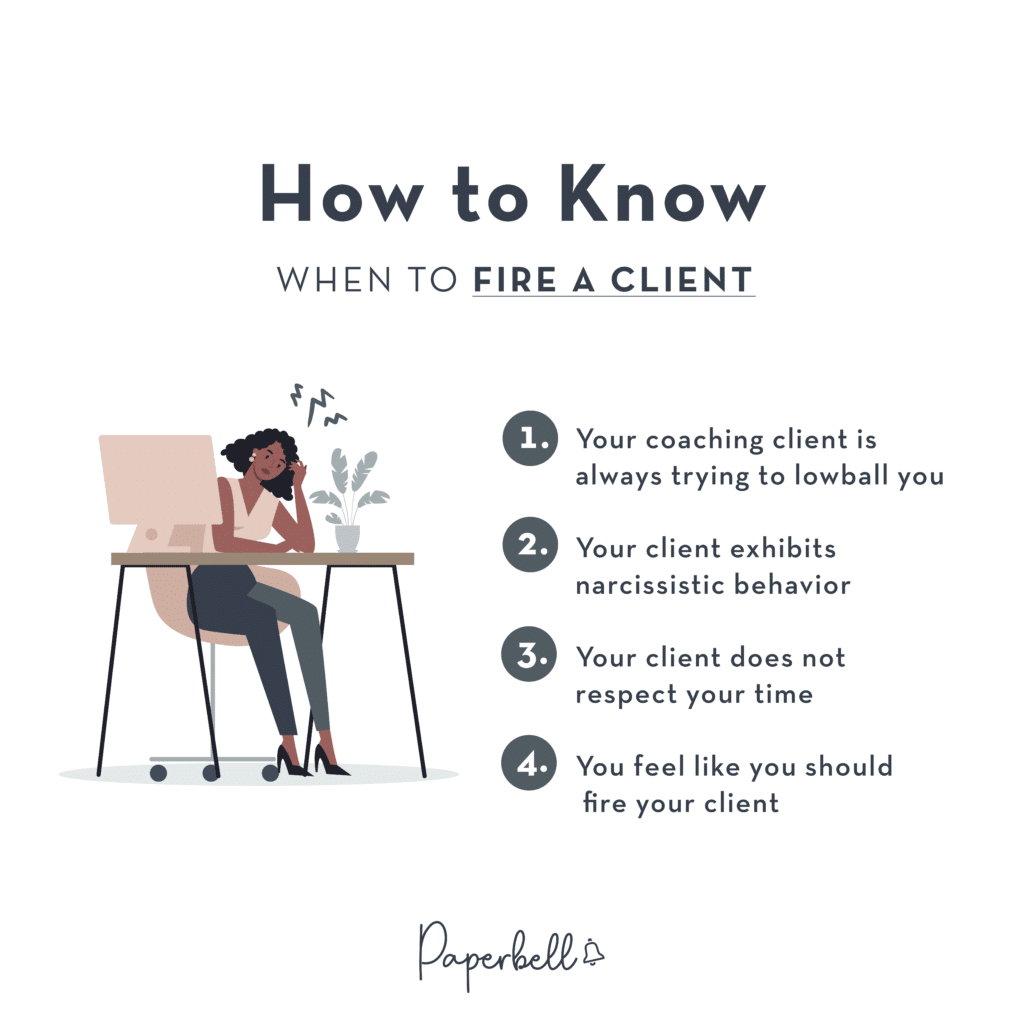Raise your hand if you’ve ever felt a pit of dread whenever you see a particular coaching client’s name pop up in your scheduling calendar or email inbox.
Yikes – nothing puts a drag on your day quite like nightmare clients you hate working with.
But as a business owner, you don’t have to remain locked in with a client hindering your coaching business instead of helping it grow.
Yes – you have permission to fire clients! Here is how to fire a client so you can start breathing again. As a coach, your own mental well-being is as important as that of your clients, so look out for yourself.
When to Fire a Client
Firing clients is rarely fun. But unfortunately, it comes with the territory of being your own boss.
Unlike finding new clients, coaches rarely ‘dream’ of the day they can fire a client. But just like clients can fire you, you have every right to fire a client when the client relationship no longer works for you.
If you’re not sure whether or not you should fire a client, here are some signs to look out for.

1. Your coaching client is always trying to lowball you
You’ve taken the time to establish your pricing, and whether your offer is a low ticket or a high ticket price, your prices are your prices.
Some potential clients may decide to haggle with you about those prices. It’s up to you to stand your ground, especially if you offer signature packages. After all, previous clients paid a certain price, so it wouldn’t really be fair to them if you gave a discount to anyone who just asks for it, right? You’re a small business and need to stay afloat somehow!
You’re entitled to give discounts if it feels right to you. But once someone becomes your client and signs your contract, both parties should respect the agreement.
When you have a client who constantly fights with you to lower the price of your sessions or ‘get a discount on the next session’, this can get draining really quickly.
Here’s the thing – your client signed the agreement, and as a result, they said they agreed to your prices. At this point, arguing over your pricing shouldn’t even be a question.
Imagine going to your car dealership every single month after buying a car and asking for a discount on this month’s car payment.
This particular client type may also try to do the following:
- Question whether or not they received what you’re invoicing them for
- Tell you another coach is offering a similar package for cheaper (hint – no other coach has your life experience and can offer exactly what you do!)
- Ask you to work hourly instead of by the package
Their cash flow issues are not your problem. If every encounter involves payment issues and a battle for your pricing, it may be time to consider an exit strategy and move on.
If you tell the client nicely that haggling isn’t acceptable, but they continue, it’s time to say bye. It’s a good business decision as problem clients waste your time and energy, and just aren’t worth the hassle. You’re running a profitable business here, not a charity. Good clients will never question your decisions on pricing once an agreement is signed.
Pro tip: Use Paperbell to manage contracts and agreements, so everything is always clear and accessible for your clients.
2. Your client exhibits narcissistic behavior
Some clients behave as if everything revolves around them. While coaching is client-centered, you still deserve respect and clear boundaries.
Watch for clients who:
- Talk down to you
- Complain about “failed” previous coaches
- Ignore payment terms or communication protocols
When multiple coaches have “failed” someone, consider whether they’re actually ready for coaching.
It’s harder to set boundaries when you lack confidence, but allowing violations early makes them impossible to correct later.
Remember: you deserve clients who respect your expertise and boundaries. If needed, have a direct conversation about non-negotiables, and be ready to part ways if the behavior continues.
3. Your client does not respect your time
Time is your most valuable resource as a coach. Even otherwise pleasant clients can become problematic when they consistently:
- Show up late to sessions
- Extend calls beyond scheduled timeframes
- Contact you during off-hours (midnight texts, anyone?)
These behaviors aren’t always malicious—some people simply have different relationships with time. However, allowing these patterns sets a dangerous precedent.
Establish clear time boundaries in your coaching agreement, including session length, cancellation policies, and communication hours. Paperbell helps automate this with built-in scheduling rules and clear client expectations.
A polite reminder often solves occasional issues, but persistent time boundary violations signal it’s time to part ways professionally.
[ Read: 7 Ways to Set (and Keep) Professional Boundaries for Life Coaches ]
4. You feel like you should fire your client
Here’s the thing: you can look for all the reasons in the world to fire a client. You can go back and forth, wondering whether it’s the right thing to do.
But when you start dreading your sessions with a particular client, or if you notice this client is taking more energy from you than you believe is fair, then that is reason enough to pull the plug on your working relationship with them.
You don’t need to wait until your client checks one of the items off the list we just covered. If it feels right to you, it’s time to go ahead and do it, even if it’s difficult to do so.
Just make sure you’re discerning the difference between a bad client and a challenging client.
Bad Client:
- Repeatedly ignores your clearly stated boundaries
- Shows consistent disrespect toward you and your time
- Makes you dread your sessions and drains your energy
Challenging Client:
- Has complex issues, but respects your professional boundaries
- Pushes you to develop new coaching skills
- Shows willingness to adapt and learn alongside you
How to Fire a Client Nicely
If you’ve decided a client relationship is no longer worth salvaging, follow these steps to end it professionally:
- Schedule a dedicated conversation – Don’t tack this onto the end of a regular session.
- Prepare your message – Choose the approach that feels most honest:
- “No longer the right fit” – Explain you’re not the ideal coach for their current needs
- “Change in circumstances” – Share that personal changes prevent you from continuing
- “Business evolution” – Describe how your practice is moving in a new direction
- Deliver with compassion – Remain calm and professional throughout the conversation.
- Provide alternative resources – If appropriate, suggest other coaches who might be a better fit.
- Handle logistics clearly – Explain exactly what happens with any remaining sessions or payments.
- Document the conversation – Send a follow-up email confirming what was discussed.
Remember to avoid blaming the client, regardless of the situation. Stay firm in your decision without getting drawn into arguments or justifications. A professional exit preserves your reputation and prevents potential negative reviews.
[ Read more: How to Say No to a Client Without Burning Bridges ]
3 Client Termination Letter Templates to Help You Fire a Challenging Client
Are you staring at your computer screen with a blank email draft staring right back at you, as you try to write a letter to fire your problem clients?
It’s tough. But you don’t have to start from scratch!
Here are some letter-to-fire-a-client templates you can use to end a bad client relationship. They are based on the three approaches discussed above.
No longer a good fit
Hi [name],
I’ve appreciated working with you over the past [amount of time].
I have given this a lot of thought, and I have come to the conclusion that perhaps we are not the best fit to work together to help you [achieve the goal they want to achieve].
This wasn’t an easy decision, but it is important to me that you find a coach who will be on the same page as you and can meet your expectations.
[Optional] I would be happy to put you in touch with someone in my network who would be a better fit, if you wish.
[Greeting and signature]
A change in circumstances
Hi [name],
It has been an honor working with you thus far. Over the past [period of time], I’ve had several changes in my life situation, and as a result, I will need to make some changes in my client base to establish a new work-life balance.
Unfortunately, as of [date], I will no longer be able to work with you. I am thankful for our time working together, and I appreciate your understanding of this business decision.
[Optional] I know you would still like to work on [their specific goal], so I would be happy to put you in touch with someone in my network who offers similar coaching services, if you wish.
[Greeting and signature]
A change in your business direction
Hi [name],
It has been an honor working with you so far. During the past [period of time], I’ve been evaluating my small business and have come to the conclusion that I need to head in a new business direction.
Unfortunately, this means I will no longer be offering [specific coaching service, package, or pricing]. As of [date], I will no longer be able to work with you.
Please know that I am thankful for our time working together, and I appreciate your understanding.
[Optional] I know you would still like to work on [their specific goal], so I would be happy to put you in touch with someone in my network who offers similar coaching services, if you wish.
[Greeting and signature]
Best Practice for Firing Existing Clients
So you’ve made the tough call to get rid of a difficult client, but what are your responsibilities to make sure you end the client relationship on good terms?
Here are some best practices to follow:
- Have an honest conversation. You know you made the right decision, so be firm about it and don’t let the client try to persuade you against it. Avoid the blame game, and while it’s ok to share the truth, blaming the client for doing something wrong isn’t going to get you anywhere. It could cause bad feelings, and remember, people talk – you don’t want to ruin any future endeavors.
- Make sure the message gets through. If you send an email using one of the sample scripts above but don’t hear anything, be sure to follow up with a phone call. You want to make sure the client actually received your communication and doesn’t just think you’re ghosting them.
- Complete any outstanding work and share the news in a timely manner. The right time to end the client relationship is probably not in the middle of a big project. There should be a transition period between firing a client and closing client relationships completely. Keep your promises and close up anything you agreed upon before you give the client the news.
- Offer other options. Don’t leave your client hanging. Suggest other coaches you think they could bond well with. It will bring you good karma and help not to leave the client with a bad feeling about you.
Break up with a Client to Make Space for Your Growth
Although firing difficult clients is challenging, both you and your client will benefit. Life is too short for client relationships that don’t serve you. Getting rid of problematic clients will give you the space and energy you need to find and work with your dream clients instead!
Now you know exactly how to fire a client; you can confidently let someone go without damaging your reputation or ability to find prospective clients. Go out there and build meaningful client relationships that make you feel good.

This article was originally published in April 2021 and has since been updated with new information.









